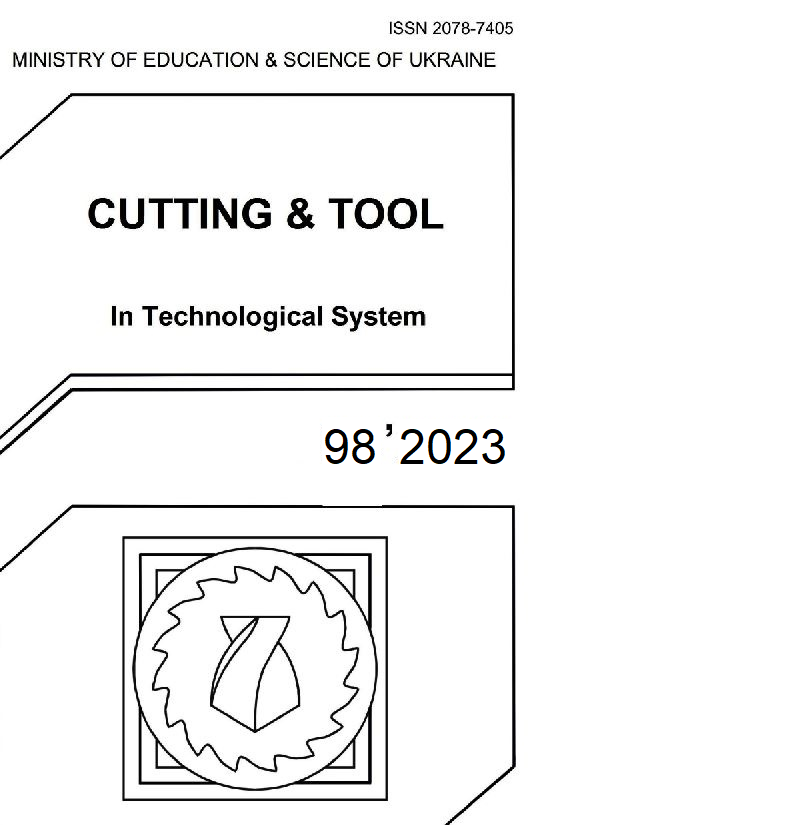ANALYZING SURFACE INTEGRITY ELEMENTS OF HARD TURNED 16MNCR5 STEEL
DOI:
https://doi.org/10.20998/2078-7405.2023.98.05Keywords:
hard turning, surface integrity, design of experimentAbstract
Surface integrity plays a determinant role in the functional requirement of precision machined parts. In the automotive industry billions of components are manufactured by using case hardened steels. In this study some surface integrity elements, such as surface roughness or residual stress are analyzed based on systematic machining experimental plan to optimize the applied cutting parameters. Recommendations are made for these parameters based on the measurement data and some widely used functional requirements.
References
Grzesik, W., Zak, K., Kiszka, P.: Comparison of Surface Textures Generated in Hard Turning and Grinding Operations, Procedia CIRP 13, pp. 84–89, 2014.
Chumak, A., Klimenko, S., Klimenko, S., Manokhin, A., Naydenko, A., Kopeikina, M., Burikin, V., Bondarenko, M., Burlakov, V.: Finish Machining of the Cutting Inserts from Cubic Borine Nitride Bl Group Composite, Cutting & Tools in Technological System 94, pp. 102-114, 2021.
Mamalis, A.G., Kundrak, J., Horvath, M.: On a Novel Tool Life Relation for Precision Cutting Tools, Journal of Manufacturing Science and Engineering 127(2), pp. 328–332, 2005.
Sztankovics, I., Kundrak, J.: Theoretical Value and Experimental Study of Arithmetic Mean Deviation in Rotational Turning, Cutting & Tools in Technological System 96, pp. 73-81, 2022.
Kundrak, J.: Alternative Machining Procedures of Hardened Steels, Manufacturing Technology 11, pp. 32–39, 2011.
Lavrinenko, V., Solod, V.: The Ralationship between the Parameters of Roughness and Features of Surface Formation with a Special Microprofile, Cutting & Tools in Technological System 96, pp. 99–109, 2022.
Balanou, M., Papazoglou, L.-E., Markopoulos, A.P., Karmiris-Obratanski, P.: Experimental Investigation of Surface Topography of Al7075-T6 Alloy Machined by EDM, Cutting & Tools in Technological System 94, pp. 3–10, 2021.
Zhao, B., Song, J., Xie, L., Hu, Z., Chen, J.: Surface Roughness Effect on Fatigue Strength of Aluminum Alloy Using Revised Stress Field Intensity Approach, Scientific Reports 11, paper 19279, 2021.
Xiao, W.L., Chen, H.B., Yin, Y.: Effects of Surface Roughness on the Fatigue Life of Alloy Steel, Key Engineering Materials 525–526, pp. 417–420, 2013.
Flack, K.A.; Schultz, M.P.; Barros, J.M.: Skin Friction Measurements of Systematically-Varied roughness: Probing the Role of Roughness Amplitude and Skewness, Flow, Turbulence and Combustion 104, pp. 317–329, 2020.
Sedlacek, M., Gregorcic, P., Podgornik, B.: Use of the Roughness Parameters Ssk and Sku to Control Friction—A Method for Designing Surface Texturing, Tribology Transactions 60, pp. 260–266, 2016.
Nagy, A.: Investigation of the Effect of Areal Roughness Measurement Length on Face Milled Surface Topographies, Cutting & Tools in Technological System 94, pp. 60–69, 2021.
Maruda, R.W., Krolczyk, G.M., Wojciechowski, S., Powalka, B., Klos, S., Szczotkarz, N., Matuszak, M., Khanna, N.: Evaluation of Turning with Different Cooling-Lubricating Techniques in terms of Surface Integrity and Tribologic Properties, Tribology International 148, paper 106334, 2020.
Jouini, N., Revel, P., Thoquenne, G.: Influence of Surface Integrity on Fatigue Life of Bearing Rings Finished by Precision Hard Turning and Grinding, Journal of Manufacturing Processes 57, pp. 444–451, 2020.
Zaghal, J., Mertinger, V., Filep, A., Benke, M.: Characterization of Residual Stress State after Turning of Bearing Rings, Doktorandusz Almanach 1, pp. 313–318, 2022.
Manovytskyi, O., Klymenko, S., Burykin, V.: Calculation of Shear Angle when Cutting with a Tool of a Negative Rake Angle, Cutting & Tools in Technological System 97, pp. 59–69, 2022.
Downloads
Published
Issue
Section
License
Copyright Notice
Authors who publish with this Collection agree to the following terms:
1. Authors retain copyright and grant the Collection right of first publication with the work simultaneously licensed under a Creative Commons Attribution License that allows others to share the work with an acknowledgement of the work's authorship and initial publication in this Collection.
2. Authors are able to enter into separate, additional contractual arrangements for the non-exclusive distribution of the Collection's published version of the work (e.g., post it to an institutional repository or publish it in a book), with an acknowledgement of its initial publication in this Collection.
3. Authors are permitted and encouraged to post their work online (e.g., in institutional repositories or on their website) prior to and during the submission process, as it can lead to productive exchanges, as well as earlier and greater citation of published work.

